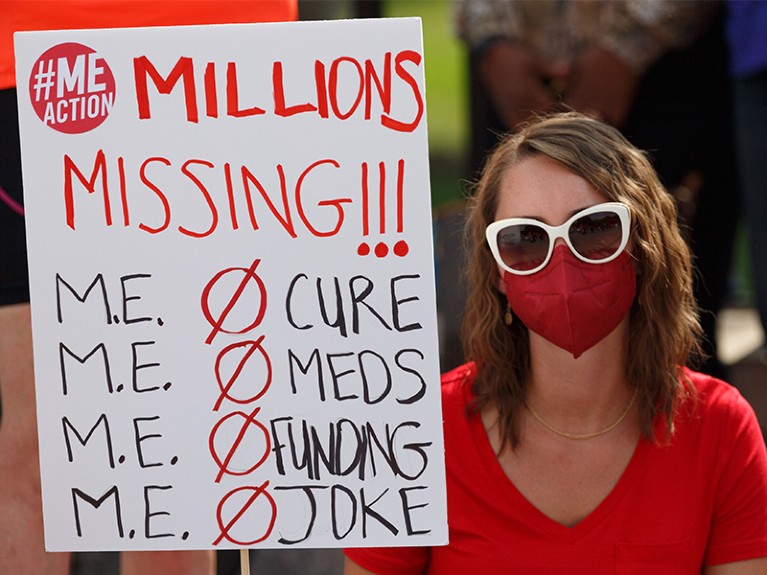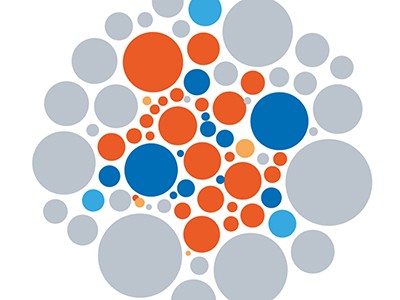
Demonstrators in Washington DC last September drew attention to the lack of funding for research into chronic fatigue syndrome, also known as myalgic encephalomyelitis.Credit: Bryan Olin Dozier/NurPhoto/Shutterstock
This year marks the 30th anniversary of a landmark US law. In 1993, it became compulsory to include women and under-represented groups in research and clinical trials funded by the US National Institutes of Health (NIH). Before the NIH Revitalization Act was passed, it was both normal and acceptable for drugs and vaccines to be tested only on men — or to exclude women who could become pregnant.
Thankfully, that has now changed. NIH data show that roughly half of participants in NIH-funded trials are women. The NIH has an office dedicated to research into women’s health and the agency mandates that researchers use both male and female animals in their studies, as appropriate. Health-research funders in Canada and Europe have adopted similar policies. The NIH has also contributed US$10 million for an Office of Autoimmune Disease Research, as directed by the US Congress — women make up approximately 80% of people with autoimmune diseases.
How menopause reshapes the brain
Nonetheless, female participation rates in some studies remain low, as affirmed by a report published in March and commissioned by the Women’s Brain Project, a non-profit body based in Guntershausen, Switzerland (see go.nature.com/44ewmd4). Women are under-represented in clinical trials in oncology and neurology1 relative to the incidence of disability and death that those diseases exert. At the same time, funding for many conditions that exclusively or disproportionately affect women is lower than for those affecting men.
Few of the world’s leading health-research funders systematically collect, analyse and publicize what they have learnt about trends in women’s-health research funding. Those scientists who are trying to fill this gap are finding data collection difficult. The NIH’s funding taxonomy, for example, does not even classify some aspects of women’s health research in a way that allows researchers to quickly obtain the information they need.
Menopause is a case in point, as Nature reports in a Feature in this issue. Despite its importance for the health of half the world’s population, menopause is under-studied. And, at least in the United States, it is difficult to track funding for menopause research, because the NIH hasn’t assigned menopause a unique identification code like the ones other conditions (such as anorexia or prostate cancer) have. Someone wanting to find out must read every grant that mentions ‘menopause’ and add up the numbers manually.
Last year, four members of the US Congress, from both parties, introduced a bill that, if passed, would require the NIH to evaluate how much has been spent on menopause research. But legislation shouldn’t be needed; the agency should classify menopause as a category in its own right so that data can be tracked as readily as for other conditions in the NIH funding database. Once this happens, policymakers, advocacy groups and researchers will better understand where the gaps in funding lie, and can start to address them.
Women’s health research lacks funding — these charts show how
Our examination of the funding landscape for women’s health reveals that this analysis is one that not many researchers seem to have embarked on. Applied mathematician Arthur Mirin is among the few to have studied funding trends in women’s-health research in the United States. Mirin came out of retirement to do this after his daughter was diagnosed with chronic fatigue syndrome, also known as myalgic encephalomyelitis. Mirin wanted to find out how much NIH funding was available in a field where women make up three-quarters of those affected. He discovered that ME/CFS attracted the least amount of NIH funding when matched against disease burden2 — measured in disability-adjusted life years (DALYs), the cumulative number of years of healthy life lost because of illness, added to the years lost because of premature death. In 2019, for example, ME/CFS research received $15 million in NIH funding, for a disease that caused more than 700,000 DALYs in the United States.
Mirin later analysed3 NIH data for other diseases, including those that predominantly affect men such as liver or prostate cancer. In the majority of cases, diseases that predominantly affect women — such as migraines, headaches, anorexia and endometriosis — received funding that was a fraction of what was awarded for diseases that predominantly affected men, when funding amounts are matched to disease burden. This is unacceptable. Mirin rightly urged the NIH to do its own funding-versus-burden analysis, and to analyse correlations between funding and gender.
The past 30 years has in many ways changed the landscape for women’s-health research. But in other respects, time has stood still. Mirin has helped to unlock a window to a previously hidden corner of research. Funders need to throw it wide open, do their own studies and establish more funding calls so that other scholars can work with them. At the same time, funders must review how they classify the components of women’s health, because that will speed up data collection. A separate identification code for menopause should not be difficult to implement.
The NIH and other health-research funders also need to give more consideration to disease burden alongside scientific merit when they assess grant proposals, because that, too, will unlock more funding for under-studied conditions. It must not take another 30 years for studies into women’s health to break free from the margins and into the mainstream.

 How menopause reshapes the brain
How menopause reshapes the brain
 Women’s health research lacks funding — these charts show how
Women’s health research lacks funding — these charts show how
 The fraught quest to account for sex in biology research
The fraught quest to account for sex in biology research
 Accounting for sex and gender makes for better science
Accounting for sex and gender makes for better science
 The researcher fighting to embed analysis of sex and gender into science
The researcher fighting to embed analysis of sex and gender into science






